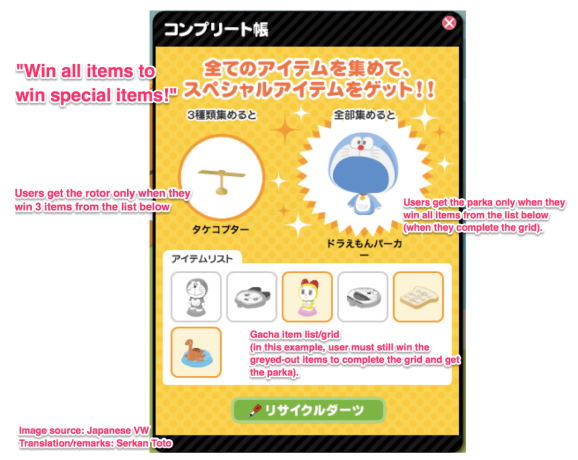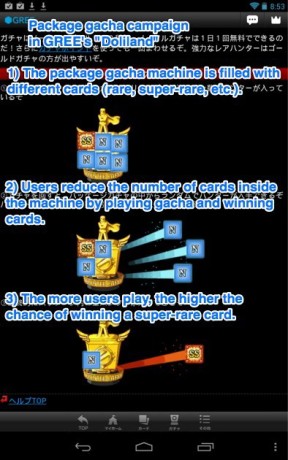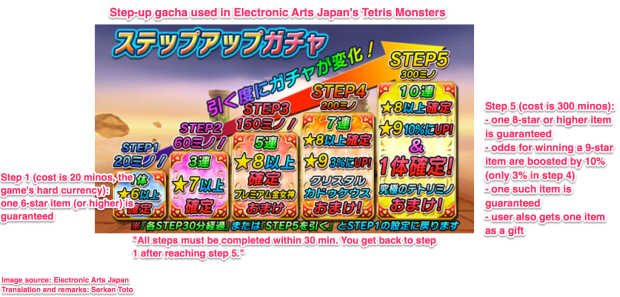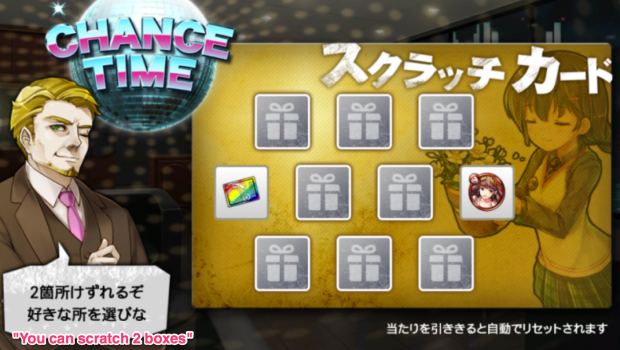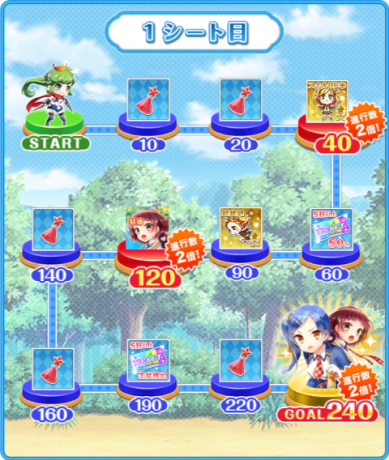About four years after the kompu gacha shock hit Japan’s mobile game industry hard, gacha as a monetization mechanic is in the news again.
This might be over soon, and I don’t intend to discuss the ethics of gacha right now (this may come soon), but please refer to my simple primer from way back in 2012 for an overview of the topic.
Fast forward to 2016, and gacha is still the top monetization mechanic used in Japanese mobile games (followed by the “continue” function and others).
One reason for the ongoing popularity is that local developers, especially after 2012, managed to find new creative ways to generate revenue from gacha.
Today, the once simple mechanic has transformed into a concept that has spawned a whole array of variations. I’d estimate that there are 10-15 general gacha mechanics, some of which have sub-variations.
In the context of this post, I introduce five of the top gacha variants that were or are being used in mobile games in Japan to address heavy spenders (“whales”) in particular.
Please note that there are several other forms of gacha I am not including in the list below, i.e. tutorial gacha, or pre-registration gacha. The gacha forms below were chosen because they are specifically designed to go after heavy spenders.
In addition, please note that I cannot go into a lot of details in the scope of this text (i.e. exact pricing, actual execution, examples of which games use which gacha variant, etc.).
5 Top Gacha Monetization Mechanics (For Hunting Whales)
1) Kompu gacha
As mentioned above, the so-called kompu gacha mechanic is not being used anymore in Japanese mobile games since 2012 (kompu is short for “complete”). Needless to say, this doesn’t affect non-Japanese developers.
Kompu gacha means that developers promise a “grand prize” that is only given to those users who win a set of other items (via gacha) first.
Here is an example of a Japanese mobile game based on popular anime character Doraemon that used the mechanic before it was shunned:
What may sound quite simple was working extremely well for developers aiming to monetize whales in particular: too well for the Japanese government, which thought the mechanic was too close to gambling and urged for it to not be used anymore.
There are cases documented where users spent the equivalent of thousands and thousands of dollars just to complete their gacha set (hence the name) in a single game in order to get the Grand Prize.
Please note that there are actually quite a few variants of kompu gacha itself – the above is just a simple example. You can find a lot more from me covering kompu gacha here.
2) Package Gacha (aka Box Gacha)
The package gacha variant gained popularity among Japanese mobile game developers around the time of the kompu gacha shock. The key factor for this mechanic is that the gacha machine in question is filled with a finite number of items.
This means that if the developer discloses how many items are inside and what the odds of winning them are, users can expect the probability to win rare items to increase with every roll, as the machine gets emptier and emptier.
It also means that is players know how many items the machine is filled with and how much each roll costs, they can exactly calculate how much it costs to get all items inside.
Here is an example:
Please note this example is from 2012, but I still think it’s a pretty interesting gacha mechanic. I covered package gacha deeper that year.
3) Step-Up Gacha
When it comes to monetizing the really big whales in particular, this gacha variant has proven to be quite effective in the case of the Japanese market.
Under this mechanic, developers “step up” the odds to win very rare items for users every time the user spends money on gacha. The first time, the reward might be just currency, the second gacha might mean the odds to win a rare item might be increased by a factor of 2, the third time by 3, etc.
The main bullet point here is that the user must be ready to pay for gacha in a single session, meaning that the overall spend (over time playing the game) on gacha doesn’t count.
To get the ball rolling, some developers offer the first step for free and then start charging for subsequent gacha until the final one is reached: the user rolls for a last time and can end the session or re-start.
Here is an example:
Some developers in Japan charge the equivalent of hundreds of dollars to complete all steps.
In the example above, the overall cost is only 730 “Minos”, the game’s hard currency. For reference, a bundle of 810 Minos costs the equivalent of US$48, so this is a relatively inexpensive step-up gacha.
4) Scratch Gacha (And Consecutive Gacha)
Scratch gacha isn’t technically gacha but is also intended to make heavy users spend more money on rare items.
There are variations of this method, but one way it can work is that developers give out “scratch points” every time users don’t roll gacha once but several times in a row (“consecutive gacha”).
I could have included these consecutive gacha as a separate way to go after whales, but the concept is simply that users who are tired of rolling single gacha one after the other (usual price: 120 yen for each roll) can opt for the machine to roll multiple times after paying a higher sum once.
The most popular variations are 5x consecutive and 10x consecutive gacha where the users just watch the machine auto-roll for a few seconds and are presented with the items they won in one swoop. Some developers offer discounts or gifts for paying for 5 or 10 gacha at once, others don’t. (I am aware this gacha variant also exists in English versions of Japanese mobile games.)
Now scratch gacha have only function: to motivate users to go and pay for consecutive gacha rolls (mostly around 600 yen for 5x or 1,200 yen for 10x), not for single ones (120 yen).
The most prominent example of a game using scratch gacha currently is GREE’s action RPG Shoumetsu Toshi:
Once enough scratch points are earned by paying for consecutive gacha, users are presented with a scratch card like the one above and can “scratch” boxes to see which (often exclusive) rewards and items they offer.
5) Sugoroku Gacha
Sugoruku is a traditional Japanese board game that served as an inspiration for this gacha variant.
The goal is to move a character across a board, from start to the last square: each square holds a reward that users can get when they pass it. Naturally, the square at the end holds the most valuable item.
In order to move the character, users need to play gacha: every time they do so, they earn the right to roll dice, play slots or some other luck-based game that determines how far the character can go on the board.
For instance, if a board has 30 squares from start to end, the sugoroku gacha is based on rolling dice, and each square is separated by 10 spaces, the user can ideally cross the board via 50 dice rolls (get the six pips 50 times).
In the simple example below, from Applibot’s card game Grimoire, the sugoroku gacha board consists of 12 squares that are separated by a different number of spaces and hold different kinds of rewards. In this case, the number of spaces the character can travel after rolling gacha is determined by a simple slot mechanic (the number the slot machine shows is equal to the number of spaces that can be traversed).
Sugoroku gacha is special in the sense that developers combine gacha with simple gambling mechanics and a kind of mini board game.
Again, please note that the list above is for “reference only”, meaning it’s neither complete nor very detailed: there are a lot more gacha mechanics used in Japanese mobile games.

